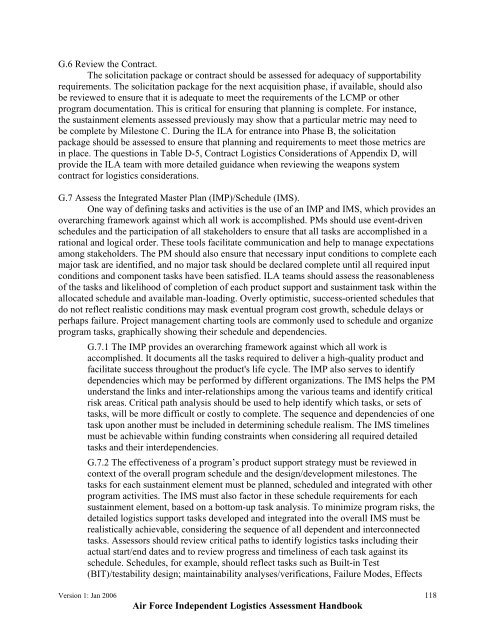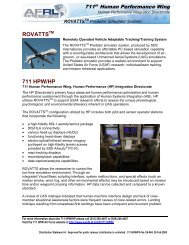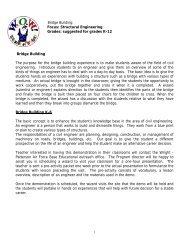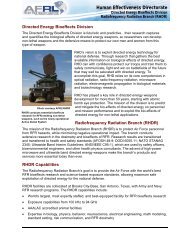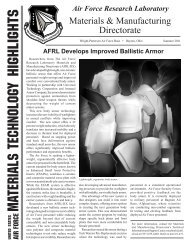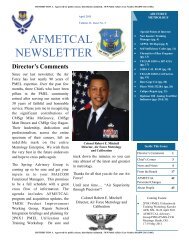USAF ILA Handbook - ACC Practice Center - Defense Acquisition ...
USAF ILA Handbook - ACC Practice Center - Defense Acquisition ...
USAF ILA Handbook - ACC Practice Center - Defense Acquisition ...
You also want an ePaper? Increase the reach of your titles
YUMPU automatically turns print PDFs into web optimized ePapers that Google loves.
G.6 Review the Contract.<br />
The solicitation package or contract should be assessed for adequacy of supportability<br />
requirements. The solicitation package for the next acquisition phase, if available, should also<br />
be reviewed to ensure that it is adequate to meet the requirements of the LCMP or other<br />
program documentation. This is critical for ensuring that planning is complete. For instance,<br />
the sustainment elements assessed previously may show that a particular metric may need to<br />
be complete by Milestone C. During the <strong>ILA</strong> for entrance into Phase B, the solicitation<br />
package should be assessed to ensure that planning and requirements to meet those metrics are<br />
in place. The questions in Table D-5, Contract Logistics Considerations of Appendix D, will<br />
provide the <strong>ILA</strong> team with more detailed guidance when reviewing the weapons system<br />
contract for logistics considerations.<br />
G.7 Assess the Integrated Master Plan (IMP)/Schedule (IMS).<br />
One way of defining tasks and activities is the use of an IMP and IMS, which provides an<br />
overarching framework against which all work is accomplished. PMs should use event-driven<br />
schedules and the participation of all stakeholders to ensure that all tasks are accomplished in a<br />
rational and logical order. These tools facilitate communication and help to manage expectations<br />
among stakeholders. The PM should also ensure that necessary input conditions to complete each<br />
major task are identified, and no major task should be declared complete until all required input<br />
conditions and component tasks have been satisfied. <strong>ILA</strong> teams should assess the reasonableness<br />
of the tasks and likelihood of completion of each product support and sustainment task within the<br />
allocated schedule and available man-loading. Overly optimistic, success-oriented schedules that<br />
do not reflect realistic conditions may mask eventual program cost growth, schedule delays or<br />
perhaps failure. Project management charting tools are commonly used to schedule and organize<br />
program tasks, graphically showing their schedule and dependencies.<br />
G.7.1 The IMP provides an overarching framework against which all work is<br />
accomplished. It documents all the tasks required to deliver a high-quality product and<br />
facilitate success throughout the product's life cycle. The IMP also serves to identify<br />
dependencies which may be performed by different organizations. The IMS helps the PM<br />
understand the links and inter-relationships among the various teams and identify critical<br />
risk areas. Critical path analysis should be used to help identify which tasks, or sets of<br />
tasks, will be more difficult or costly to complete. The sequence and dependencies of one<br />
task upon another must be included in determining schedule realism. The IMS timelines<br />
must be achievable within funding constraints when considering all required detailed<br />
tasks and their interdependencies.<br />
G.7.2 The effectiveness of a program’s product support strategy must be reviewed in<br />
context of the overall program schedule and the design/development milestones. The<br />
tasks for each sustainment element must be planned, scheduled and integrated with other<br />
program activities. The IMS must also factor in these schedule requirements for each<br />
sustainment element, based on a bottom-up task analysis. To minimize program risks, the<br />
detailed logistics support tasks developed and integrated into the overall IMS must be<br />
realistically achievable, considering the sequence of all dependent and interconnected<br />
tasks. Assessors should review critical paths to identify logistics tasks including their<br />
actual start/end dates and to review progress and timeliness of each task against its<br />
schedule. Schedules, for example, should reflect tasks such as Built-in Test<br />
(BIT)/testability design; maintainability analyses/verifications, Failure Modes, Effects<br />
Version 1: Jan 2006 118<br />
Air Force Independent Logistics Assessment <strong>Handbook</strong>


